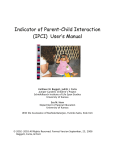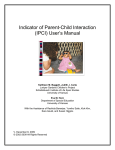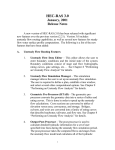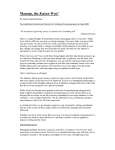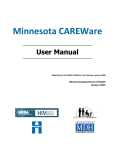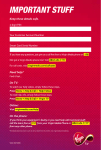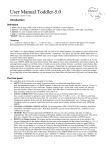Download Photography - International HIV/AIDS Alliance
Transcript
Photojournalism / Change the world Module 9: This module will help you understand: • Why photography is important in telling your story • The basics of taking a good photo • How to manage your photos • The ethical issues of photojournalism Seeing is believing We are a visual species. Scientific studies show that visual communication even trumps verbal as the dominating sense. Our eyes help us pay attention, remember and understand the world around us. One reason images are great at grabbing attention is they can communicate a story in an instant. This can be invaluable in our fast-paced world, where people often lack time to read a news story let alone another long advocacy report. We are also more likely to believe what we see with our own eyes than what is merely reported to us by someone else. So although the written word can be extremely powerful, when it is coupled with an image the impact on our thoughts, emotions and decision-making can be magnified exponentially. Citizen journalists who want to change the world – take note! What makes a good photo? Think carefully about choosing the subject of your photo according to the story you want to tell. When it comes to advocacy and writing for change, generally people make the best subject rather than objects or landscapes. A good photo will: • tell a story by giving context • show people as active rather than posed • create a sense of connection and show eye contact • capture emotion and expression (excitement, anger, determination etc). If your goal is to engage people with gritty issues but to motivate them and make people believe they can be part of the solution, then it is best to avoid shots that show apathy and portray people as helpless victims. © Sheikh Rajibul Islam\duckrabbit\International HIV/ AIDS Alliance Photojournalism Access to information on sexual and reproductive health issues is critical in combating the HIV epidemic 75 Change the world / Photojournalism © Nell Freeman/International HIV/AIDS Alliance 76 How to take a good photo Every camera is different and you need to study the manual and practice taking photos to understand the functions and how to operate your camera. However, taking good photographs requires a lot more skill, knowledge and experience than simply knowing how to operate your camera. The best way to improve is to take lots of photos and also spend time looking at the work of good photographers. Focus When you take a picture you want the subject to be sharp. This is done by pushing the shutter button half-way down and it will automatically focus on the subject, then you press all the way down to take the shot. A mother in the Ivory Coast washes her two-month old baby As you can see from the diagram the camera is focused on the face of the woman (the squares indicate where the camera is focused). The face will be sharp and the rest of the image will not be sharp. It is also possible to use manual focus on more advanced cameras. However, when learning there is so much to remember it is a good idea to stick to autofocus. Depending on how you set your camera up (refer to your user manual), autofocus will select either the closest point (as it has in this example) or the centre of the frame, and it could be that this is not the subject you want the camera to focus on. For example, it could be you want the boat to be in focus and not the woman. It is best to set your camera up so the autofocus is set to the centre of the frame as this gives you more control. Then if you want the woman to be in focus, you would: • put her in the centre of the frame • press the shutter half-way down to focus • re-frame the shot so she is at the side (keeping the shutter button half-way depressed) • once you’re happy with the composition, press the button all the way down to take the shot . Top tips: • On most cameras you hold the shutter button down half-way to focus, then press all the way down when you’re ready to take the shot. • Make sure you have a firm stance and concentrate on holding the camera as still as possible. • After taking a photo, check that it is sharp and not blurry. • If it is blurry try again. If you are using the manual settings on your camera you may need to make some adjustments to allow more light in, such as changing the aperture size, shutter speed or ISO. • If you are using the automatic setting and you are holding your camera really still but the picture is still blurry, then think about how you can create more light in your physical environment. For example, make sure your subject is positioned with the light source directly on them, open curtains and turn on the lights. If you are inside and can’t get enough light, consider going outside if there is more light there. • For night time and early evening shots, you will need to allow for slower shutter speeds. In low light take every opportunity to steady your arm, for example by using a wall, windowsill or tree to lean against. Photojournalism / Change the world Light is very important as a photo is made by capturing light on film or the sensor of a digital camera. Photographers speak of the golden hours which are around sunrise and sunset, because at these times colours are at their best and you will get the most beautiful pictures. In the middle of the day when the sun is high in the sky it creates shadows and it can be difficult to take portraits. Photos will lack depth and will look flat with faded colours. It is always worth taking your photos early in the morning or at the end of the day whenever possible. Normally the rule is to always have the sun from behind you or from the side. If you take a photo of a subject with the sun from behind the subject, the subject will be black and you will only see the sun. So always be aware of where the sun is in relation to your subject. You can also deliberately take a photo directly facing the sun for a nice sunset or when you want the subject to be just a silhouette. © Gemma Taylor/Alliance Light and exposure Exposure consists of three elements: Under exposed 1. ISO: the measure of digital camera sensor’s sensitivity to light triangle shutter speed aperture If you are using the automatic setting on your camera you don’t need to worry too much about exposure. If you are using manual settings then it is important to remember that a change in one of the elements will impact the others. This means that you can never really isolate just one of the elements alone but always need to have the others in the back of your mind. 1. ISO In digital photography ISO measures the sensitivity of the image sensor. The same principles apply as in film photography – the lower the number the less sensitive your camera is to light and the finer the grain. Higher ISO settings are generally used in darker situations to get faster shutter speeds (for example an indoor sports event when you want to freeze the action in lower light) – however the cost is shots which are grainier. It’s best to shoot at the lowest ISO setting of the camera, this is usually 100. If you go higher you will get more noise (weird pixels/grains) in your images. This is no problem during day time but indoors or at night time this might result in moved/ blurry photos because the shutter time was too long and the camera has moved while capturing the image. In these circumstances you can use a higher ISO setting, such as 400. Remember, the higher you go with the ISO the chance of a blurry picture is less but the quality will go down, especially with cheaper cameras. 2. Aperture Aperture is the size of the opening in the lens when a picture is taken. When you take a picture (by hitting the shutter release button of your camera) a hole opens up that allows your camera’s image sensor to catch a glimpse of the scene you want to capture. © Gemma Taylor/Alliance 3. Shutter speed: the amount of time that the shutter is open the exposure Correctly exposed © Gemma Taylor/Alliance 2. Aperture: the size of the opening in the lens when a picture is taken ISO Over exposed 77 78 © Sarah Oughton/British Red Cross Change the world / Photojournalism A slower shutter speed captures the motion of this fisherman in Bangladesh throwing out his net Setting the aperture changes the size of the hole; the larger it’s set the more light gets in, the smaller the hole the less light. Aperture is measured in ‘f-stops’ also referred to as ‘f/number’ – for example f/2.8, f/4, f/5.6,f/8,f/22 etc. Moving from one f-stop to the next doubles or halves the size of the opening in your lens (and the amount of light getting through). One thing that causes a lot of new photographers confusion is that large apertures (where lots of light gets through) are given f/stop smaller numbers and smaller apertures (where less light gets through) have larger f-stop numbers. So f/2.8 is in fact a much larger aperture than f/22. It seems the wrong way around when you first hear it but you’ll get the hang of it. f2.8 more light f5.6 f8.0 f11 less light 3. Shutter speed Shutter speed is the amount of time that the shutter is open, which means the length of time the image sensor ‘sees’ the scene you’re attempting to capture. • Shutter speed is measured in seconds – or in most cases fractions of seconds. The bigger the denominator the faster the speed (ie 1/1000 is much faster than 1/30). • In most cases you’ll probably be using shutter speeds of 1/60 (which means it is a sixtieth fraction of a second) or faster. This is because anything slower than this is very difficult to use without getting camera shake. Camera shake is when your camera is moving while the shutter is open and results in blur in your photos. • If you’re using a slow shutter speed (anything slower than 1/60) you will need to either use a tripod or some type of image stabilisation. © Gideon Mendel/International HIV/AIDS Alliance Photojournalism / Change the world 79 A faster shutter speed freezes the action in this game of tag - a game used by Sports in Action to educate youth about HIV • Shutter speeds available to you on your camera will usually double (approximately) with each setting. As a result you’ll usually have the options for the following shutter speeds – 1/500, 1/250, 1/125, 1/60, 1/30, 1/15, 1/8 etc. This ‘doubling’ is handy to keep in mind as aperture settings also double the amount of light that is let in – as a result increasing shutter speed by one stop and decreasing aperture by one stop should give you similar exposure. • When considering what shutter speed to use in an image you should always ask yourself whether anything in your scene is moving and how you’d like to capture that movement. If there is movement in your scene you have the choice of either freezing the movement (so it looks still) or letting the moving object intentionally blur (giving it a sense of movement). • To freeze movement in an image you’ll want to choose a faster shutter speed and to let the movement blur you’ll want to choose a slower shutter speed. The actual speeds you should choose will vary depending upon the speed of the subject in your shot and how much you want it to be blurred. • Motion is not always bad. There are times when motion is good. For example when you’re taking a photo of a waterfall and want to show how fast the water is flowing, or when you’re taking a shot of a racing car and want to give it a feeling of speed. In these instances choosing a longer shutter speed will be the way to go. However you need to use a tripod or you run the risk of ruining the shots by adding camera movement (a different type of blur than motion blur). • Focal length (zoom) is another thing to consider when choosing shutter speed. Longer focal lengths will accentuate the amount of camera shake you have and so you’ll need to choose a faster shutter speed. The rule of thumb to use with focal length is to choose a shutter speed with a denominator that is larger than the focal length of the lens. For example if you have a lens that is 50mm then 1/60 is probably okay, but if you have a 200mm lens you’ll probably want to shoot at around 1/250. Top tips: • The light source should be on the subject (sun behind you). • The first two hours and the last two hours of daylight are the best time for taking photos. • Bright sunlight can lead to harsh shadows and the subject squinting. Try putting the subject in the shade for a softer more flattering image. • Switch off your flash, unless you have professional equipment and know how to use it. • Study your camera manual and learn how to change the ISO, shutter speed and aperture so you can adjust the exposure. © Sarah Oughton/British Red Cross Change the world / Photojournalism © Sarah Oughton/British Red Cross 80 Composition Diagram 1 Diagram 2 As you frame your shot, imagine this grid overlaid on what you see as you look through your viewfinder or on the LCD display. With this grid in mind you can identify four important points in the composition where you should consider placing the most interesting parts of your subject. For example, when taking photos of people you should consider positioning their eyes on one of the top two intersections as you frame your image – see diagram one. The second diagram shows four lines which are also useful for positioning elements in your photo. © Sarah Oughton/British Red Cross The rule of thirds is an excellent guide for creating compelling compositions. The basic principle is to imagine breaking an image down into thirds, both horizontally and vertically, so that you have nine parts. Top left: Young woman on an early morning errand in Sierra Leone Above: In Sierra Leone a mother with a baby strapped to her back washes clothes in the river © Sarah Oughton © Sarah Oughton/British Red Cross Photojournalism / Change the world The theory is that if you place points of interest in the intersections or along the lines that your photo becomes more balanced and helps a viewer interact with the image more naturally. Studies show that when viewing images people’s eyes usually go to one of the intersection points most naturally rather than the centre of the shot – using the rule of thirds works with this natural way of viewing an image rather than working against it. The rule of thirds applies equally to photos in a landscape composition (see above opposite), as well as portrait composition (see opposite). However, for the Key Correspondents website (and for most websites) always try to take a landscape composition, as this works better due to the design and layout of most web pages. The rule of thirds technique is just as important for shots of landscape as those of people and horizons should be positioned along one of the horizontal grid lines, which you can imagine being overlaid on the two shots above. One of the most common mistakes in photography is forgetting to pay attention to getting the horizon exactly horizontal. As you can see in the picture above right, it’s an easy mistake to make. When framing your shot, always think about the rule of thirds and always double check your horizon. Using the rule of thirds can take a little time and practice for it to become second nature. The most important questions to ask are: • What are the points of interest in this shot? • Where am I intentionally placing them? Top left: A community affected by a cyclone along Bangladesh’s coast in the Bay of Bengal Top right: A boat moored at a jetty at a lake in Guatemala 81 Change the world / Photojournalism Background Backgrounds present both opportunities and challenges to photographers. On the one hand they can put a subject in context and make it stand out in a way that highlights it wonderfully – but on the other hand backgrounds can overwhelm subjects and distract from them. Strategies for dealing with distracting backgrounds: Checking the background before taking the shot is vital to avoid making mistakes in photographs. Look for colours that don’t fit with the rest of the image, bright patches that might distract the eye, lines that clash, people that don’t belong, trees or poles sprouting out the top of people’s heads etc. Changing your shooting angle if you have distracting elements in the background of a shot is probably the first thing you should consider. This might mean rotating around your subject but could also include getting down low to make the sky the background or even getting up high and shooting down onto your subject to make the background the ground. Moving your subject is a simple technique but can make a huge difference to the background and is another effective strategy. Often asking the subject to take a step to the left or right will fix things either by putting the distraction behind them or by putting it out of frame. Using aperture to blur backgrounds is one of the most useful techniques to learn as a way to combat distractions in backgrounds (and foregrounds). What you’re trying to achieve is a nice blurred background where you can’t really make out what’s going on. The easiest way to do this is to use a wide aperture. The wider your aperture the more blurry your background will become. Remember a wide aperture is denoted by a low f-stop, such as f2.8. Using focal length to blur backgrounds is another way to help get your backgrounds nice and blurry and requires a lens with a long focal length which you use to zoom in. Placing subjects in front of open spaces will also help to make the background more blurry. For example if you have the choice between shooting your subject standing right in front of a brick wall or standing in front of an open field – the open field shot will have a much more blurred background simply because the brick wall is just centimetres from your subject and inside the focal range whereas an open field stretches off into the distance where everything will be out of focus. Filling your frame with your subject is one of the most effective ways of removing distractions from backgrounds. Get up close and/or use your zoom lens to tightly frame the shot and you’ll not only remove distractions but could end up with a high impact shot as well. © Sarah Oughton/British Red Cross 82 Woman standing outside her home in Sierra Leone 83 © Gemma Taylor/Alliance © Gemma Taylor/Alliance Photojournalism / Change the world Point of view Top tips One of the most effective ways to make your images more interesting to the eye is to change the angle that you’re shooting from. • Move in close: get physically close or zoom in on your subject to reveal interesting details, such as a person’s freckles, wrinkles or an arched eyebrow. • Move your subject from the middle: the centre of your picture is not always the best place for your subject. Bring your photos to life by simply moving your subject away from the middle of your picture. Remember the rule of thirds. • Lock the focus: if your subject is not in the centre of the photo, you need to lock the focus to create a sharp picture. First, centre the subject and press and hold the shutter button halfway down. Reposition your camera (while still holding the shutter button) so the subject is away from the centre and press the shutter button all the way down to take the picture. • Be ready: keep your camera on you and not packed in your bag so it’s easy to take a shot at short notice. Ensure that you have enough batteries, film or memory to last the day. These photos of boats in Malaysia illustrate this point. Of course perceptions about photos are subjective and the angle you choose will also depend on the context and story you are trying to communicate. In the first picture taken with a wide angle you get a sense of setting, scale and landscape, but there is little indication of the human element of the story. The second picture taken much closer up gives a completely different feeling. You see the fishermen and you get a different sense of the scale of the fishing boats in relation to the people and the work involved. Not only does changing the angle you shoot from impact the feeling of size of your subject but it also affects the light and shade and patterns. Always try taking shots of your subject from different angles. While standard wide angle shots can be good for context, getting in really close and finding unusual angles can bring a ‘wow’ factor to your shot. The variety of perspectives that you can shoot images from is only limited by your imagination. A photograph has the ability to convey emotion, mood, narrative, ideas and messages – all of which are important elements of storytelling. The gift of storytelling isn’t something that just happens – good storytellers are intentional about learning how to tell stories and practice their craft. Stories come in all shapes and sizes. Some are long (novels or even trilogies of novels) but others are short. Thinking photographically, short stories might be just one or two images. Single image stories • Most newspaper photography fits into this category of storytelling – one image that attempts to capture the essence of an accompanying written story. They don’t have the luxury of multiple frames to introduce, explore and conclude so almost always tell the story of a single event rather than a longer one. • Such shots need to have something in them that grabs the attention of a viewer. They also will usually have visual and/ or narrative focal points that lead the viewer into the photo. • Short story photos are often shots that leave the viewer of the photograph wondering about what they are looking at – not because they don’t understand it but because they intrigue and leave people imagining what is going on behind the image and what other future images of the scene might look like. In a sense these single image stories are often just as powerful because of what they don’t include in the shot as to what they do include. • When telling a story through a single image think about including more than one person in the shot – when you do this you introduce ‘relationship’ into a photo which will conjure up all types of thoughts in the viewers of your shots. • Having said that, sometimes carefully framing a second person out of your shot can add to the story you’re trying to tell. Leaving evidence in the shot of a second unseen person can add questions to your viewers’ minds. Unseen elements of a photo can add a lot. • Also think about context – what’s going on around your subject? What’s in the background? What does the other elements of the photo say about your subject and what’s going on in their lives? Of course you don’t want to be too obvious about setting your background up – doing so could lead to clichéd shots. Multiple image stories • One of the mistakes many new photographers make is that they find they need to put every possible element of a story or scene into each photograph that they take. This leads to photos that can be quite cluttered, that have too many focal points and that confuse the viewer. • One way to avoid this and still tell a story with your images is to take a series of shots. In a sense what you’re doing here is a step towards shooting a movie (a movie is a sequence of many thousands of images run together to tell a story). Rachel, 30, at home in Walvis bay, Namibia. © Gemma Taylor/International HIV/AIDS Alliance Storytelling © Gemma Taylor/International HIV/AIDS Alliance Change the world / Photojournalism As a transgender woman Rachel was rejected by her own family at age 12. Here she is with her neighbour’s baby. © Gemma Taylor/International HIV/AIDS Alliance 84 She likes the attention she gets as a sex worker. “I feel a diva, I feel like a celebrity, I feel like Beyoncé! When Beyoncé walks into a room everyone turns and looks at her.” Good stories don’t just happen. They take planning and some type of structure. Before you start photographing your story consider what type of shots you might need to tell it. Basic stories will usually include the elements of: introduction, plot/body and conclusion. 1. Introduction These shots put the rest of the images into context. They introduce important characters, give information about the place where the story is happening, set the tone of the story and introduce the themes. Introductory shots need to lead viewers into the body of the story. If you think about a good novel, it’s often the first few paragraphs that determine whether people will buy and read the book in full or not – the same is true with visual stories. Introductory shots should give people a reason to go deeper into the story. Good stories explore ideas, feelings and experiences on a deeper level. Plot shots will make up the majority of your photographic story. They show what happens but also explore themes and ideas: • Issue themes – the crux of the story, the main subject. • Visual themes – perhaps colors or shapes that come up again and again. • Stylistic themes – repetition of photographic techniques and styles. • Locational themes – reoccurring photos from similar types of places. • Relational themes – shots that focus upon a person or people over time. 3. Conclusion Good storytellers are quite intentional about the way they end their stories. Last impressions count and it’s worth considering what lasting image you want to leave with the viewer of your photos. By no means do you need to tie up your story neatly (good stories sometimes leave people feeling unsettled and wanting resolution) but do consider how you want to end. Rachel routinely tests for HIV and advises other sex workers to do the same, as well as using condoms to prevent HIV: “I can’t do a risky job and ignore my health.” © Gemma Taylor/International HIV/AIDS Alliance Structure 2. Plot She has established ‘Voice of Hope’, a community-based organisation which aims to increase sex workers’ access to health services, and improve their knowledge of their fundamental human rights. © Gemma Taylor/International HIV/AIDS Alliance • Series of shots used to tell a story can be anything from two or three shots arranged in a frame or collage through to hundreds of shots arranged in an album (online or printed). 85 © Gemma Taylor/International HIV/AIDS Alliance Photojournalism / Change the world Rachel is a strong role model: “Let’s be proud of who we are, as a sex worker, as a transwoman, but first and foremost a human being, with dignity and integrity.” Change the world / Photojournalism © Sheikh Rajibul Islam\duckrabbit\International HIV/AIDS Alliance 86 Managing your photos Editing Novels never go to press in their original form. They generally take a lot of reworking and editing to get them into a form that will work. The same is usually true with photographic storytelling. Editing happens on a number of levels and ranges from the editing of single photos (cropping, sharpening, enhancing of colors etc through software programmes such as Photoshop) through to the editing and presentation of the overall series of shots. Good photographers take a lot of photos, but they know they won’t all be winning shots. The most important part of the editing process is being ruthless with your selection of photos. Remember photos should grab attention and increase the impact of a story. Always keep two sets – one with all your images and one with your carefully edited selection of the very best shots. Crediting and captions Crediting photographs is standard international practice. Crediting, and the inclusion of the copyright symbol – © – in the credit, is especially important on the web, because of the ease with which images can be copied. Crediting also facilitates the subsequent identification and tracking of the image, and acknowledges the photographer. Captions are important because they provide additional context about the image. Whenever possible, a caption should include the name and age of the principal subject(s) and the country and locality where the image was taken. If a photograph is older than the text story it accompanies, it is important to also reference the year the image was taken. Do not repeat information that is already evident by looking at the image: use captions to make an additional advocacy point about your subject. Young people aged 15-24 account for 40% of new HIV infections globally. Over half of Ethiopia’s population is in this age group © Sheikh Rajibul Islam\duckrabbit\International HIV/ AIDS Alliance © Benjamin Chesterton\duckrabbit\International HIV/AIDS Alliance Photojournalism / Change the world When taking a photo this is the basic information you should always try to write down to help with filing and captioning your photos at a later date. For people: Above left: Momina walks her six year old son Rapira to school •Name Above: Youth club dancer Samson wants to make Ethiopian culture known to the world •Age • Family (brothers, sisters, parents) • Where do they live (country/city/region) • Job, volunteering or family responsibilities • Description of what they are doing in the photo • How are they linked to any project/programme • Photo number (from the camera) For location: • Area (village/town/city/country) • Interesting facts on community/population, history, special features • Photo number (from the camera) Photojournalism and ethics The motivation for using an image should always be well thought out. Ask yourself, what does the image add? Does it enhance the viewer’s understanding of a situation? Does it allow the viewer to learn something about the subjects, how they live or their attitudes? Most importantly, be sure to use images in their accurate context. Your photographs should be documentary depictions of real people, in real situations. Misrepresenting that situation, by – inadvertently or intentionally – implying your subjects are someone, or somewhere, or implicated in something, that they are not, is a violation of their right to fair and accurate representation, as upheld in many national laws. Finally, image misrepresentation can weaken your credibility as a reliable source of information. 87 Change the world / Photojournalism © Sarah Oughton/British Red Cross 88 The need for special protection of children and women depicted in images is especially crucial when addressing controversial or culturally sensitive topics, such as child labour, sexual exploitation, gender violence or discrimination, recruitment of child soldiers, trauma, and the stigmatising impact of these and other issues, such as HIV. When photographing or filming a child, the child’s best interests should always be the primary consideration. Filming or photographing a child should be a positive experience for them and they should always be accompanied by a parent or guardian. Informed consent (including a signed model release form) must be obtained for all vulnerable people and children (see module three on interviewing for further information). It is important that images of children portray the reality of their lives but also respect their dignity, privacy and rights. Children should never be depicted in erotic, seductive, provocative poses or contexts (even if illustrating the trafficking of girls, for instance). Ensure that all children represented in images are fully dressed. Do not use images of nude children, children that appear to be wearing no clothes, children in transparent clothes or children with their genitals or upper body uncovered. Children that have experienced violence, exploitation or have been otherwise abused should not have their faces displayed or be represented in a way that may lead to their identification. Where possible, show children being active and resourceful and where relevant, include families, parents or guardians. A young girl in remote village in Mali drinks water from a small bucket during a food crisis (2012) Tips for photographing children: • Avoid looking down on children – use low angles • Try to get natural candid shots when they are not posing • Get permission from them and their guardian – make sure that telling their story and revealing their identity will not bring repercussions within their community Photojournalism / Change the world © International HIV/AIDS Alliance Rashida, a young transgender woman from Mymenshing, Bangladesh, finds it challenging to be accepted for who she is in a very conservative society While some images have to illustrate reality and need, they shouldn’t compromise a person’s dignity. Images of ‘needy’, vulnerable people, may generate support in the short-term, but they can often perpetuate the negative opinion that a poor country’s problems will never be solved. This doesn’t help the efforts of countries that are seeking international investment, and a stronger voice in global decisionmaking processes. Key Correspondents should think about how their imagery can promote gender equality by showing women as equal to men, actively engaged in their community and bringing about change. Think about challenging visual stereotypes of women as powerless, passive or dependent victims. Always ask yourself: ‘If I was this person, would I want my story told in this way?’ If your story focuses on a specific individual, but they do not want to be identified in a photo, you have to find a different way to tell the story visually. You could ask them if you could take a photo from an angle that would not reveal their identity. However, if your subject is not comfortable being photographed at all, then you need to get creative and think about the different elements in the story. Can you photograph their anti-retroviral medication, or their drugusing equipment? Does the story refer to a specific clinic? Could you go there and ask for permission to photograph the waiting room? Is hunger a big issue in the story? If so get a picture of the subject’s empty bowl. 89 Change the world / Photojournalism © Benjamin Chesterton\duckrabbit\International HIV/AIDS Alliance 90 Rapira wants to be a doctor when he’s older so that he can treat people like his mother who is living with HIV Exercise Resources: You have one hour to take 50 photos. This is an opportunity to experiment and try out different techniques, such as choosing a subject and taking many shots from different angles, for example: These resources provide excellent information to further develop your photojournalism skills: • climbing above it • finding a weird angle • lying or crouching in front of it • putting the camera on the ground and chancing it. Also, remember to try: • the rule of thirds • blurring the background • playing with different light sources. Resource Media Seeing is believing: a guide to visual storytelling best practices: resource-media.org/visual-story-lab/ report/ World Pulse This citizen journalism curriculum has many excellent modules, including one on multimedia storytelling: worldpulse.com/pulsewire/ solutions/71046

















